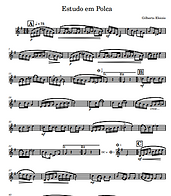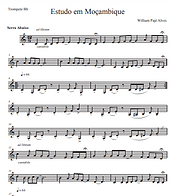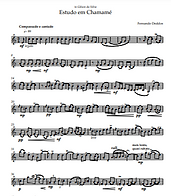EIGHT
Brazilian
genre studies
for solo trumpet
The project "Eight Brazilian Genre Studies for Solo Trumpet" explores Brazil’s vernacular music. In collaboration with four composers (Fernando Deddos, Gilberto Eloízio, Weberton Figueiredo, and William Alves), it presents 1) the commission of studies for solo trumpet, 2) research on the genres selected by the commissioned composers, 3) the recording of these studies performed by the author of this project, and 4) a website page presenting the research outcomes, which also include a playlist with music examples and sheet music scores available for download. The musical genres addressed are dobrado, polca, valsa, maxixe, vassi, moçambique, chamamé, and milonga.
A brief history of
Brazilian Popular Music
The roots of Brazilian vernacular music are directly related to the Portuguese colonization of Brazil and the consequent cultural exchange, most often imposed by force and violence, among Brazil’s social groups. José Ramos Tinhorão, a researcher and historian of Brazilian vernacular music, states that vernacular music “is a contemporary creation of the emergence of cities with a certain degree of social diversification.” From this perspective, vernacular music in Brazil only developed in the 18th century with the advent of urban centers. Prior to that time, during the first 200 years of Portuguese colonization in Brazil, the only types of music heard were the songs of the ritual dances of indigenous people who lived in a nomadic state or communities administered by Jesuits (an estimate over 2 million indigenous); the batuques of the African enslaved people, most often also rituals and staging of African fights (circa of 4 million enslaved people); and, finally, the songs of the European colonizers, cultivated by an minority of whites and free mestizos, employed in the cities (circa of 100 thousand immigrants).
Acknowledgments
First, I would like to extend my deepest gratitude to the composers who collaborated with me on this project: Fernando Deddos, Gilberto Eloisio, Weberton Figueiredo, and William Alves. Their artistry inspired my endeavors to build a project that resonates with their passion and commitment to Brazilian music.
I would also like to express my sincere appreciation and acknowledgment to my advisor, Professor Jean Laurenz, for her unwavering support and willingness to share her knowledge. I am extremely grateful for all her guidance and effort toward my musical growth.
My appreciation also goes to my DMA committee members, professors Daniel Grabois, David Crook, and Scott Teeple. Their invaluable advice, continuous support, and patience have encouraged me in my academic experience and greatly supported the conclusion of this project.
I would also like to acknowledge the members of the Wisconsin Brass Quintet, professors Daniel Grabois, Jean Laurenz, Mark Hetzler, and Tom Curry. This chamber ensemble nurtured my passion for music and offered me the best learning experience I could have ever asked for. Certainly, my happiest moments at UW-Madison were spent alongside these marvelous musicians. Their artistry and shared experience will continue to inspire my future musical endeavors.
I must express my profound gratitude to my family and friends for providing me with unfailing support and continuous encouragement throughout my academic journey. To my father, Sebastião da Silva, whose love for me knew knows no bounds and whose good example taught me the value of humility and companionship. Finally, in memory of my beloved mother, Célia de Nazaré Silva, the strongest and most honest person I have ever known.
Thank you,
Gilson Da Silva
.jpg)
Batuque, 1835
Johann Moritz Rugendas (1802 -1858)
The
Etudes
The musical genres addressed in the “Eight Brazilian Genre Studies for Solo Trumpet” come from different periods in the history of Brazilian vernacular music and reflect cultures from different regions of the country. First, Gilberto Eloízio and Weberton Figueiredo explored the genres of European influence – valsa, polca, and dobrado – popular in the country at the end of the 18th century. In contact with Brazilian culture, these genres acquired elements from the different social groups during the rise of the urban centers. The buoyant culture of the cosmopolitan urban center was also responsible for the birth of other Brazilian musical genres, for example, the maxixe, which emerged from the influences of polka, lundu, and tango. Next, William Alves explored the rhythms of African culture, the vassi and moçambique, recalling more than 300 years of enslavement that brought around 4.8 million Africans to Brazil. Finally, Fernando Deddos composed two studies, exploring the chamamé and milonga. These genres echo the influence of the native people in South America and their contact with Spanish colonizers in the beginning of the 15th century, a culture typical in the Pampas, a shared biome that extends across Brazil, Argentina, and Uruguay.
In addition, listening carefully to musical examples and reading the information about each genre is highly recommended before playing the study. Given the oral tradition of Brazilian vernacular music, its performance practices significantly differ from one group to another. In this context, the student is invited to listen to music examples with attention to the subtleties of character, phrasing, articulation, rhythmic patterns, musical form, melodic structure, and modulation tendencies, among other musical elements. This attentive listening and immersion into the genre’s social environment and musical characteristics can significantly enrich the investigation of the genres and offer a context for an informed musical performance. In addition, note that the trumpet is not an instrument commonly used in some genres investigated. Therefore, the piece's execution on the trumpet is conditioned to imitating the timbers and sound of the originals instrument. Listening to music examples with attention to sound colors and phrasing is vital to understanding the musical language and performance practices of the genres.
Brazilian Etudes for Solo Trumpet
DMA Lecture Recital
In this recital, I discuss the importance of the first urban centers for the development of Brazilian vernacular music. To illustrate the written content, I am pleased to premiere some etudes part of the Brazilian Etudes for Solo Trumpet commission. In addition, I selected some footage of a popular market in Belo Horizonte, Mercado Novo. This place translates the diversity of Brazilian popular culture discussed in the lecture.
This project is presented in partial fulfillment of the
requirements for the Doctor of Musical Arts degree in Trumpet Performance at the
University of Wisconsin - Madison







